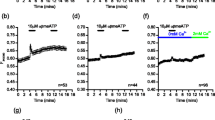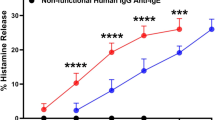Abstract
RBL 2H3 cells, a model for mast cell function, sensitized with rat IgE, released histamine and peptidoleukotrienes (LT) in response to rabbit anti-rat IgE in a concentration-dependent manner. The calcium ionophore, A23187 also stimulated the release of both mediators but to a greater extent. The protein kinase C activator, 12-O-tetradecanoyl phorbol-13-acetate (TPA) failed to influence mediator release when added alone, but when added with either A23187 or anti-IgE, TPA significantly enhanced the release of both histamine and LT. The effects of anti-IgE, TPA and A23187 were completely inhibited by prior addition of the protein kinase C inhibitors staurosporine and 1-(5-isoquinolinesulfonyl)-2-methylpiperazine dihydrochloride (H7) but not by N-(2-guanidinoethyl)-5-isoquinoline-sulfonamide dihydrochloride (HA1004), a compound which has similar potency to H7 as an inhibitor of some protein kinases but is less potent as a protein kinase C inhibitor. Although other explanations are possible, these results support the hypothesis that the release of histamine and leukotrienes from RBL 2H3 cells resulting from the cross bridging of the IgE receptors, is dependent on activation of protein kinase C.
Similar content being viewed by others
References
H. Metzger, G. Alcaraz, R. Hohman, J. P. Kinet, V. Pribluda and R. Quarto,The receptor with high affinity for immunoglobulin E. Ann. Rev. Immunol.4, 419–470 (1986).
J. R. Cunha-Melo, N. M. Dean, J. D. Moyer, K. Maeyama and M. A. Beaven,The kinetics of phosphoinositide hydrolysis in rat basophilic leukemia (RBL-2H3) cells varies with the type of IgE receptor cross linking agent used. J. Biol. Chem.262, 11455–11464 (1987).
J. R. White, D. H. Pluznik, K. Ishizaka and T. Ishizaka,Antigen-induced increase in protein kinase C activity in plasma membrane of mast cells. Proc. Natl. Acad. Sci.82, 8193–8197 (1985).
M. A. Beaven, J. Rogers, J. P. Moore, T. R. Hesketh, G. A. Smith, and J. C. Metcalfe.,The mechanism of the calcium signal and correlation with histamine release in 2H3 cells. J. Biol. Chem.259, 7129–7136 (1984).
S. Nagao, K. Nagat, Y. Kohmura, T. Ishizuka and Y. Nozowa,Redistribution of phospholipid/Ca ++ dependent protein kinase in mast cells activated by various agonists. Biochem. Biophys. Res. Comm.142, 645–653 (1987).
R. Sagi-Eisenberg, J. C. Foreman and R. Shelley,Histamine release induced by histone and phorbol ester from rat peritoneal mast cells. Eur. J. Pharmacol. 113, 11–17 (1985).
C. Palacios and E. Pinatado,Effect of protein kinase C activation on mast cell histamine release. Biochem. Int.15, 441–449 (1987).
R. Sagi-Eisenberg and I. Pecht,Protein kinase C, a coupling element between stimulus and secretion of basophils. Immun. Lett.8, 237–243 (1984).
R. P. Schleimer, E. Gillespie and L. M. Lichtenstein,Release of histamine from human leukocytes stimulated with the tumor-promoting phorbol diesters I. Characterization of the response. J. Immunol.126, 570–574 (1981).
D. O. Thueson, J. A. Kennedy, C. D. Wright and M. C. Conroy,Specific inhibition of phorbol ester and DiC8-induced histamine release from human basophils by the protein kinase C inhibitors, H7 and H9. Biophys. Res. Commun.144, 732–740 (1987).
Y. Katakami, K. Kaibuchi, M. Sawamura, Y. Takai and Y. Nishizuka,Synergistic action of protein kinase C and calcium for histamine release from rat peritoneal mast cells. Biochem. Biophys. Res. Comm.121, 573–578 (1984).
M. E. Cantwell and J. C. Foreman,Characteristics of the effects of phorbol ester on rat mast cells: interaction with anti IgE. Agents and Actions.18, 77–88 (1986).
A. S. Heimen and F. T. Crews,Characterization of the effects of phorbol esters an rat mast cell secretion. J. Immunol.134, 548–555 (1985).
R. P. Stump, J. M. Oliver, E. J. Cragoe and G. C. Deanin,The control of mediator release from RBL 2H3 cells: Roles for Ca 2+,Na + and protein kinase C. J. Immunol.139, 881–885 (1987).
M. E. Cantwell and J. C. Foreman,Phorbol esters induce a slow non-cytotoxic release of histamine from rat peritoneal mast cells. Agents and Actions.20, 165–168 (1987).
S. Jacobsen, H. S. Hansen and B. Jensen,Synergism between thapsigargin and the phorbol ester 12-O-tetradecanoyl phorbol-13-acetate on the release of [14C]arachidonic acid and histamine from rat peritoneal mast cells. Biochem. Pharmacol.36, 621–626 (1987).
A. M. Gilfillan, G. A. Wiggan and A. F. Welton,Protein kinase C (PKC) mediates the release of histamine (H) and leukotriene C 4 (L) from RBL 2H3 cells. J. Cell. Biol.107, 276a (1989).
R. P. Siraganian,An automated continuous-flow system for the extraction and fluorometric analysis of histamine. Anal. Biochem.57, 383–391 (1974).
F. Wroblewski and J. S. La Due,Lactate dehydrogenase activity in blood. Proc. Soc. Exp. Biol. Med.90, 210–213 (1955).
M. Kurosawa and C. W. Parker,Characterization of calciumactivated, phospholipid-dependent protein kinase from rat serosal mast cells and RBL-1 cells. Cell Immunol.103, 381–393 (1986).
Y. Morita, T. Takaishi, Z. Honda and T. Miyamoto,Role of protein kinase C in histamine release from human basophils Allergy.43, 100–104 (1988).
H. Hidaka, M. Imagaki, S. Kawamoto and Y. Sasaki,Isoquinolinesulfonamides, novel and potent inhibitors of cyclic nucleotide dependent protein kinase and protein kinase C. Biochemistry.23, 5036–5041 (1984).
T. N. Lo, W. Saul and M. A. Beaven,The actions of Ca 2+ ionophores on rat basophilic (2H3) cells are dependent on cellular ATP and hydrolysis of inositol phospholipids. J. Biol. Chem.262, 4141–4145 (1987).
T. Tamaoki, H. Nomoto, I. Takahashi, Y. Kato, M. Moromoto and F. Tomita,Staurosporine, a potent inhibitor of phospholipid/Ca ++ dependent protein kinase. Biochem. Biophys. Res. Commun.135, 397–402 (1986).
R. V. K. Vagesna, H.-L. Wu, S. Mong and S. T. Crooke,Staurosporine inhibits protein kinase C and prevents phorbol ester-mediated leukotriene D 4 receptor desensitization in RBL-1 cells. Mol. Pharm.33, 537–542 (1988).
S. Kawamoto and H. Hidaka,1-(5-Isoquinolinesulfonyl)-2-methylpiperazine (H-7) is a selective inhibitor of protein kinase C in rabbit platelets. Biochem. Biophys. Res. Commun.125, 258–264 (1984).
H. M. Gonzaga, H. Ali, J. R. Cunha-Melo, F. L. Huang, and M. A. Beaven,Antigen-induced signals differ from those generated by phorbol myristate acetate (PMA) and A23187 in rat basophilic (RBL 2H3) cells. J. Cell. Biol.107, 56a (1989).
Author information
Authors and Affiliations
Rights and permissions
About this article
Cite this article
Gilfillan, A.M., Wiggan, G.A. & Welton, A.F. The effects of the protein kinase C inhibitors staurosporine and H7 on the IgE dependent mediator release from RBL 2H3 cells. Agents and Actions 30, 418–425 (1990). https://doi.org/10.1007/BF01966307
Received:
Accepted:
Issue Date:
DOI: https://doi.org/10.1007/BF01966307




